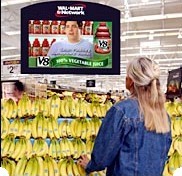February 21, 2005
Banana-Vision?
The four largest television networks in the United States, are NBC, CBS, ABC and Fox.
Quick, what's the fifth largest network?
According to Wal-Mart and to an agency that handles its ad sales, the TV operation captures some 130 million viewers every four weeks, making it the fifth-largest television network in the United States after NBC, CBS, ABC and Fox. - Source.
 It seems that Wal-Mart TV has been nick-named Banana-Vision, supposedly because a large monitor is always installed above the bananas. However, it seems that with this distraction, shoppers are not being as picky about their bananas.
It seems that Wal-Mart TV has been nick-named Banana-Vision, supposedly because a large monitor is always installed above the bananas. However, it seems that with this distraction, shoppers are not being as picky about their bananas.
I don't think that banana dog would approve.
The New York Times article explains why Wal-Mart is spending so much on a TV network.
PEARLAND, Tex. - Here in the Houston suburbs, Banana-Vision has arrived. That's the industry nickname for the 42-inch high-definition L.C.D. monitor installed directly over a pyramid of bright yellow bananas in the produce section of the local Wal-Mart store.Posted by Susan R at February 21, 2005 06:42 PMThis TV screen and others scattered through the store are part of the Wal-Mart TV Network, a Web network of in-store programming that the company started in 1998. These days it shows previews of soon-to-be-released movies, snippets of sports events and rock concerts, and corporate messages from the world of Wal-Mart, including some intended to improve its battered public image.
But the principal reason for Wal-Mart TV is to show a constant stream of consumer product ads purchased by companies like Kraft, Unilever, Hallmark and PepsiCo. And little wonder. According to Wal-Mart and to an agency that handles its ad sales, the TV operation captures some 130 million viewers every four weeks, making it the fifth-largest television network in the United States after NBC, CBS, ABC and Fox.While other retailers have experimented with in-store television, Wal-Mart's network, which is available in almost all its 2,600 locations, is the most extensive. The company, eager to promote it, is upgrading its broadcasting plans and equipment.
"It's sort of a neat idea," said Beatrice White, a Houston resident who said she bought bananas every time she went to the store, but had just noticed the screen above them. "I just walked up here and I was looking at it. I think if you've got children with you, it would entertain them."
Armando Rivera, a Wal-Mart worker who was shopping after his shift, said the programs included sports from time to time, and "sometimes I'll stand and watch it for a while."
Late last year, the company hired Nielsen Media Research to evaluate its network (Nielsen does not regularly measure Wal-Mart TV viewers the way it does with the broadcast networks). The study found that shoppers watched Wal-Mart TV an average of seven minutes a store visit, 44 percent longer than in a similar study in 2002.
That growth has caught the eye of marketers that in the age of TiVo and proliferating cable channels are searching for other ways to send their messages to an increasingly hard-to-reach consumer.
According to Wal-Mart's rate card, advertisers pay $137,000 to $292,000 to show a single commercial for a four-week period, depending on the length of the ad and the number of stores where it is shown.
PepsiCo's Frito-Lay division has been bulking up on its ads in Wal-Mart for the last five years, said Haston Lewis, a vice president at Frito-Lay.
"From a marketing standpoint," Mr. Lewis said, "we want to be on the cutting edge of identifying and leveraging the most effective vehicles to capture consumers. The reality is unlike 40 or 50 years ago, more and more of your customers are shopping at Wal-Mart. So they have become a new medium to reach consumers."
As part of Wal-Mart's TV upgrade, some 600 of the 42-inch screens are to be installed by December and eventually every store will have them. The monitors they are replacing were one step removed from 1960's models, able to broadcast color but bolted high above shoppers' heads and easily overlooked.
And the company plans to tailor its broadcasts more specifically to areas of its stores - like electronics, produce or deli - and to individual stores, based on regional tastes and situations.
The placement of the wide, difficult-to-ignore screen at the store near Houston in the last few months represents one part of Wal-Mart's effort to capitalize on its captive audience. In the produce aisle, the TV screen gets shoppers' attention, thanks to its big size and lighted face, and from speakers installed on the ceiling, which create a kind of pathway of sound that can make even focused buyers turn toward its source.
Across the way in the delicatessen area is another screen, with different programming, and on the other side of the store, in electronics, is another.
The power of televised distraction is clear.
"A lot of them are picking up bananas and not even looking at them," said Dale Koehler, the store manager, referring to his customers. "They're looking at the TV."